Spider-view: "Emergence"
This annual stands apart from its contemporaries by providing a story based on compelling writing and nicely structured art
—by Nathan on November 10, 2025—
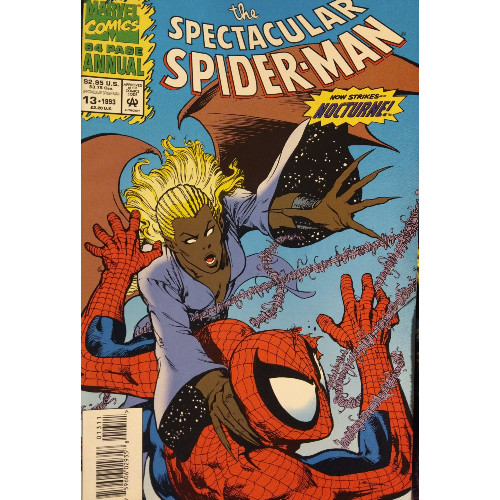
The theme of Marvel's 1993 annuals was, apparently, "brand new characters," a concerted effort to introduce new heroes, villains, and anti-heroes into the larger universe in the hopes of rallying audiences around new faces through established titles. I wasn't aware this was actually intentional on Marvel's part until opening this annual, which introduces the villainess/quasi-anti-hero Nocturne. Huh, interesting that all three Spidey annuals introduced brand new characters, I thought to myself before doing a little Googling and learning that, yeah, it was more than interesting, it was intentional and not just limited to Spidey books.
And Marvel wanted you to know. I assume this was true of the other annuals, but my copies of Web of Spider-Man Annual #9 and Spectacular Spider-Man Annual #13 came polybagged, with a little trading card giving fast facts about the new character and a blurb reading:
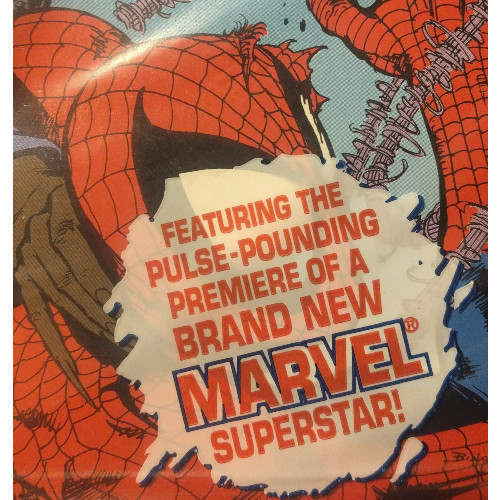
Yes, the Marvel Universe was abuzz with new faces, apparently each one provided a "pulse-pounding premiere." I am sure other folks more aware of the breadth of the 1993 annuals could detail the wider results of that claim, but this series is limited to Spidey books, and we've already examined the first two 1993 annuals: Amazing Spider-Man Annual #27 introduced Annex, a former soldier turned into an armored anti-hero who could call up weapons out of basically virtual energy. Cool concept, but I felt the story lagged a little. The aforementioned Web of Spider-Man annual gave us the Cadre, three siblings born with incredible abilities who find themselves squaring off against Spidey and Code: Blue after leaving their monasterial home. It was an entertaining enough annual, with some neat visuals, but it also lacked any true staying power, like ASMA #27.
We still have one more annual, though, courtesy of Spectacular Spider-Man Spider-Man (no annual this year for the "adjectiveless" Spider-Man). Veteran writer J.M. DeMatteis creates a new character who, surprisingly, is more compelling than the other folks introduced around the same time as she was Her appearances have been limited, but for one issue, Nocturne gets to soar a little…both literally and figuratively.
"Emergence"
Writers: J.M. DeMatteis, Marc Levine, and Glenn Herdling
Pencilers: Jerry Bingham, M.C. Wyman, and John Romita Sr.
Inkers: Jerry Bingham, Hector Collazo, Keith Williams, M.C. Wyman, and Al Milgrom
Colorists: Joe Rosas, John Kalisz, and Marie Javins
Letterers: Joe Rosen and Steve Dutro
Issue: Spectacular Spider-Man Annual #13
Publication Dates: September 1993
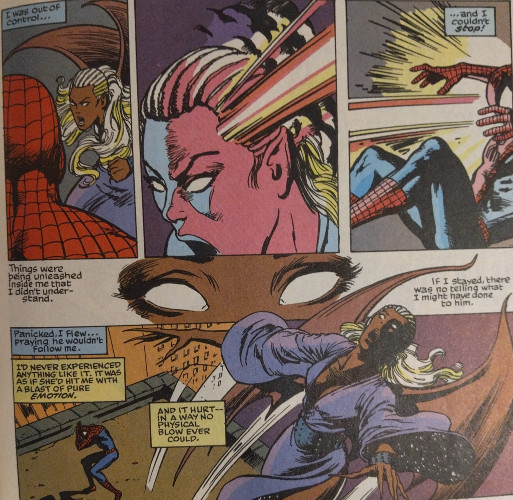
I'm gonna flip the script a little here: instead of moving from the main story to the back-up strips, I'm going to start with the smaller pieces. Most of this annual, following the format of the other Spidey annuals, contributes the bulk of its length to introducing Nocturne, across two tales. The other strips, featuring previously introduced characters Black Crow and the Prowler, feel largely included for padding. The Prowler has popped up periodically in these blogs, mostly as the subject of other short stories within annuals. He's an interesting character–I've always been fond of his design–but he's used here in a marginally okay story featuring kung-fu masters the Sons of the Tiger. Heck, though billed as the Prowler, it's Hobie Brown who initially shows up, sans costume, sans claws for the first few pages. We get some kung-fu action and a bit from writer Glenn Herdling about Hobie's own insecurities but nothing much to appreciate, even with the John Romita Sr. art.
The Black Crow back-up plays to DeMatteis' strengths as a writer, as he develops a Native American superhero's own bout of self-consciousness into a plot involving the demon D'spayre. DeMatteis is able to say more about Crow in these brief pages, allowing his demonic antagonist to serve as a physical embodiment of his theming. Both stories feel interested in exploring heroes grappling with fear and uncertainty, and I'd argue DeMatteis possesses the writing chops to toy with the idea more strategically in the space he's provided.
Ultimately, each back-up tale feels necessary to round out the page count, with DeMatteis far more interested in the main event: the coming of Nocturne.
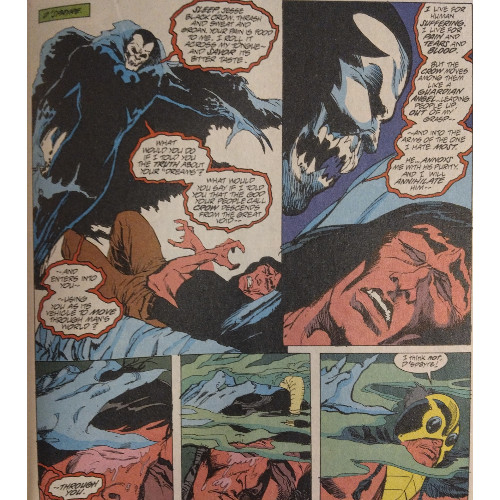
Opening the annual and seeing DeMatteis' name in the credits caused me to sigh in relief. The man is one of my favorite Spider-Man writers, developing not just the ever-popular "Kraven's Last Hunt" but the famous Spectacular Spider-Man #200 as well as the strongest chapters in "Maximum Carnage." DeMatteis' way of writing, with care and attention poured into each of his sentences, generates stronger stories, stronger dialogue, and stronger characters. As in "Kraven's Last Hunt," he employs a method of narrative which allow both Nocturne (former police officer Angela Cairn) and Spidey to speak into the narrative, each character given their own voice and motivations as the plot unfolds. I expected a much-stronger story, and I received one.
DeMatteis develops Nocturne as a fully-fledged character, though I suppose introducing her alter ego in an earlier issue of his SSM run with Sal Buscema was a boon. Though the groundwork was laid earlier, DeMatteis capably presents her as an interesting individual, with a backstory that feels naturally woven into the issue and motivations which feel understandable. Driven by the grief of losing a coworker and friend, Angela seeks to avenge her death, winding up the victim of an experiment which transforms her into the winged Nocturne, cursed with the ability to manifest her emotions as physic waves she uses against her foes. DeMatteis, wrapping tragedy around her in the first few pages, increases the stakes for our anti-heroine, and a scene where a cruel monster tortures her generates more empathy than I had for other characters introduced in these annuals.
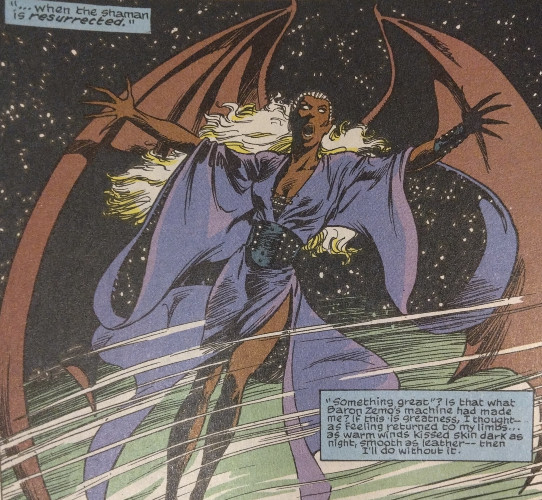
All of this is laid out delicately by DeMatteis, who isn't invested in jumping headfirst into fisticuffs territory. The other two annuals felt more interested in bringing us into a fight and then laying out the story once the rumble began. DeMatteis does the opposite, crafting a genuine plot and letting that story influence the conflict and tension later. Much of this also stems from the fantastic pacing used by Jerry Bingham, who I know primarily from his work on Mike Barr's Batman: Son of the Demon graphic novel. As DeMatteis intentionally introduces details, it's Bingham who distributes the visuals, carefully constructing scenes for maximum impact. Whether it's focusing on a photo of Angela and her friend to emphasize their relationship, or painstakingly rendering Angle's horrific torture, or methodically detailing Angela's first flight as Nocturne, Bingham is considerate about how he develops the story's artistic pacing, letting individual moments sink in and infusing individual scenes with the emotional weight they deserve.
A wonderful strand of irony is laced throughout the issue, as Nocturne, having lost her voice, becomes entangled in a case of mistaken identity between herself, Spider-Man, and a serial killer. DeMatteis weaves the serial killer elements in from the start, the pieces culminating in a final showdown that also nicely utilizes Nocturne's limitations and Spidey's (understandable) leap to certain conclusions. It's genuinely great tension DeMatteis provides her: how can a voiceless anti-hero defend herself against our Web-Head, especially when the piece's real villain manipulates the situation further? It's difficult to describe without providing spoilery details, but let's just note DeMatteis brings these three characters–Nocturne, Spidey, and the central antagonist–into a perfect storm of misplaced judgements that generate situational irony for our dear Peter Parker.
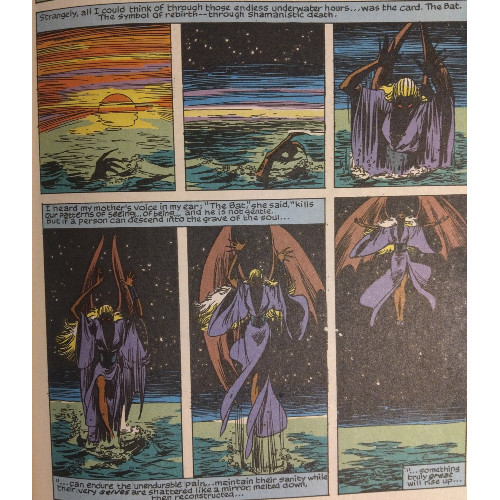
This is not a complaint, but readers should be aware this annual is reliant on narratives DeMatteis wrote for both Captain America and SSM issues published shortly before the "death" of Harry Osborn. Elements involving the history of man-rat Vermin and references to Baron Zemo play into the narrative. I didn't mind DeMatteis pulling in these pieces of the past–like with using an established character like Angela, he capably constructs this whole story on other foundational aspects he laid in past narratives. It makes the whole issue feel more sound than other annuals, which employed so many new characters and concepts that focus was divided between telling a story and educating the reader.
Maybe I'm not being fair to the other annuals. Maybe because I'm not as familiar with writers Eric Fein and Terry Kavanagh, I didn't feel that same hint of elation I did when seeing DeMatteis' name in the credits. Maybe knowing a writer I enjoy wrote this story prejudiced me towards appreciating it more than the others.
Maybe.
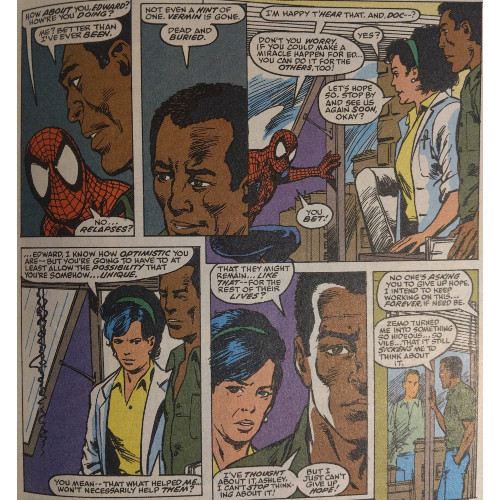
Alternatively…it could be that this story is just better. It could be that the characterization is solid, the art creates an intentional flow through which the narrative is told, the action feels derived from the story rather than being the central focus of the issue. Yes, I'm biased. I like DeMatteis. He's a darn good writer, and I tend to enjoy the way he develops stories. So knowing he wrote this did give me confidence the other writers didn't, even before I flipped to this annual's first page. Maybe that's a little unfair. Or maybe DeMatteis is like the definition of his central character: as a nocturne is a classical musical composition intended to invoke feelings of a gentle nighttime, so is DeMatteis a clever writer whose name tends to evoke feelings of solidity and engagement.